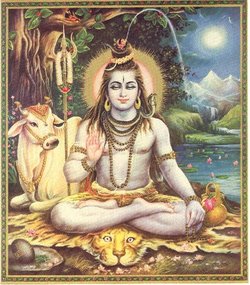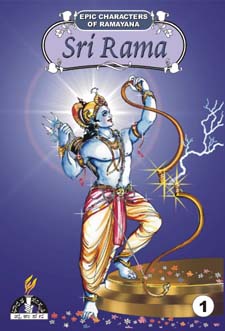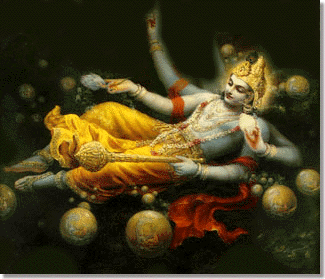

Lord Shiva
Shiva
Along with Brahma,
the creator, and Vishnu, the protector, Shiva makes up one third of the
trinity of Hindu gods. Shiva is the
destroyer and regenerator, and is one of the oldest gods of India.
There have been images of Shiva found in India, which date back as far as
2500 BC.
-----------------------------------------------------------------------------------------------------------------------------------------------------------------------------------------------------------------------------------------------------------

Lord Rama
Rama was Lord Hari Himself incarnate on earth for the destruction of Ravana. He was well accomplished, beautiful and endowed with royal marks. He was the foremost of those who were skilled in the use of bows and arrows. He was born of the Ikshvaku line. He had his sway all over the world.He had eyes like lotus-petals and a countenance like the full moon. His arms were long and beautiful. He had broad shoulders. His eyes were red. He had a deep voice. He had proportionate limbs. His gait was slow and majestic. It was like that of a lion. He had four lines on his thumb. He had a pointed nose. He had a high forehead. His glory and powers were unlimited. He was peerless on earth. He was free from malice. He was gentle and the protector of his people. He always addressed the people in gentle words. He never used harsh words even when anybody addressed him rudely. He was wise and virtuous. He was effulgent like the sun, in forgiveness like the earth, in intelligence like Brihaspati, in frame like Vasava, in prowess like Indra. He observed ascetic vows and honoured saints. He would forget hundreds of evils done to him but would gratefully remember a single act of kindness, ever shown. In the leisure of his martial exercises, he had discussions on the Sastras with the wise and the aged people. He always followed the right in every walk of his life and never swerved from his royal duties. If anybody approached him, he would talk to him first. He was exceedingly powerful but never haughty. He was the upholder of the four castes. He conferred honor upon people. He was worshipped by all. He was well versed in polity and greatly devoted to the Brahmins. He was a friend of the poor and chastiser of the wicked. He was a cosmic benefactor. He was well versed in religion, social customs and laws. He looked after the welfare of his subjects and the people too loved him immensely. He never indulged in profane and irrelevant talks. He had mastery of Yajur Veda, Dhanur Veda, the Vedangas, etc. Whenever people put a question to him he answered them wisely like Brihaspati. He was skilful in the use of arms. He was honored by the scholars of the Vedas. He was proficient in philosophy and poetry. He never spoke a lie even in extreme danger or peril. He was brave, candid and modest. He was the source of all good. He always respected, his superiors. He was free from idleness. He was ever vigilant. He sought no evil. He had perfect control over anger.He was ever ready to keep vigilant watch over his own faults. He had aged and pious Brahmins for his guide. He was an expert rider, a great warrior, a valiant general. He had great skill in all the military maneuvers. He was unconquered even by the gods. He was free from the evil habit of carping. Sri Rama is an Avatara of Lord Hari. Lakshmana is an Avatara of Adisesha. Bharata and Satrughna are Avataras of the conch and discus. Sita is an Avatara of Sri Lakshmi. Sri Rama possessed red eyes and his arms were sinewy. His steps were like those of an elephant. He had long arms, broad shoulders and black, curly hair. He was valiant and glowing with splendor. He was in no way inferior to Indra himself in battle. He was well versed in holy scriptures and equal to Brihaspati in wisdom. He was skilled in every science. He was an object of love and reverence with all people. He had his senses under perfect control. Even his enemies were pleased to see him. He was the terror of the wicked and the protector of the virtuous. He was endowed with keen intelligence. He could never be vanquished by anyone. He renounced the throne and the pleasures of the senses and the world to fulfill the words of his father. If Rama had longed for the throne, it was quite easy for him to get it. He was very popular. He was the mightiest of heroes. He destroyed the Rakshasas and bent the tremendous bow of Lord Siva. But he did not show the least physical force. He gladly accepted what was dictated by the cruel and wicked Kaikeyi. The throne possessed less fascination for him than the obedience of his father’s behests. He renounced the kingdom and the comforts of a king. He gladly accepted exile. The laudable virtues of Sri Rama cannot be adequately described. Of all the four brothers Sri Rama was a paragon of virtues. He was not only kind and affectionate but generous and considerate of feelings for all around him. He had a splendid physique and winning manners. He had a magnanimous personality. He was extremely noble, generous, chivalrous and fearless. He was very simple and absolutely free from ostentation. Sri Rama’s life was a life of holy obedience, of stainless purity, of matchless simplicity, laudable contentment, commendable self-sacrifice and remarkable renunciation. He paid equal respect to his mother and his stepmothers and revered his Guru. Sita once told Rama to seek shelter in a safe place and let the forest dwellers alone as there was much danger there. Rama’s reply revealed his firm determination to adhere to truth, and to his duty as a king to protect those who took shelter under him. Sri Rama said, "O Sita, I may even give up life or you or Lakshmana but can never give up the fulfillment of my word given particularly to helpless Brahmins. Rama speaks but once and never fails to keep up his promise." Sri Rama was happy in adversity, calm in miseries, intrepid in dangers. Sri Rama was a mighty hero. He was the hero of heroes. Single-handed, he killed great and renowned warriors like Khara and Dushana. He vanquished the invincible Vali. He was an ideal king. He ruled the kingdom in a wonderful way. He was just and righteous. He was courageous and kind. He was endowed with a gentle and generous disposition. He was civil and courteous. His subjects loved him immensely. Not a single man was unhappy during his regime. He often used to say, "I will do anything and everything to please my subjects, and, if necessary I can even abandon my dear wife for their sake." That is the reason why his reign was called "Ramarajya." There were no dacoits during his regime. All led a virtuous life. Nobody spoke any untruth. Anybody could leave a bag of gold or jewels even in the main street. No one would touch it.
-----------------------------------------------------------------------------------------------------------------------------------------------------------------------------------------------------------------------------------------------------------

Lord Brahma
Symbolizes the aspect of the Supreme Reality that brings forth the creation. For this very reason, Hindus call Lord Brahma the Creator of the universe. He is the first member of the Hindu Trinity that also includes Lord Vishnu and Lord Shiva. His divine consort is Saraswati, the Goddess of learning and knowledge. Goddess Saraswati provides Lord Brahma with knowledge that is necessary for the process of creation. Brahma is usually conceived of by Hindus as a bearded, four-faced, four-armed deity. In popular images, He carries a rosary in the upper right hand, a book in the upper left hand, a kamandalu (water pot) in the lower left hand, and bestows grace with His lower right hand. The four faces represent the sacred knowledge of the four Vedas (Rig, Yajur, Sama, and Atharva), and this is the most prominent feature of any image of Brahma. The four faces, therefore, symbolize that Brahma is the source of all knowledge necessary for the creation of the universe. The four arms represent the four directions and thus represent the omnipresence and omnipotence of Lord Brahma. The four hands represent the four aspects of human personality: mind (back right hand), intellect (back left hand), ego (front right hand), and the empirical self or conditioned consciousness (front left hand). The rosary symbolizes the time cycle through which the world moves from creation to sustenance, from sustenance to dissolution, and from dissolution to new creation. The rosary also symbolizes the materials used in the process of creation. Its position in the back right hand suggests the intelligent use of these materials in the process of creation. A book in the back hand (symbolizing the intellect) illustrates that right knowledge is important for any kind of creative work. A water pot (kamandalu) in the front left hand symbolizes the cosmic energy by which Brahma brings the universe into existence. The hand symbolizing ego (the front right hand) is shown in the pose of bestowing grace. This conveys the idea that the Lord bestows grace and protects all sincere devotees. The color gold symbolizes activity and thus the golden face of Brahma indicates that the Lord is active when involved in the process of creation. The white beard denotes wisdom and the long beard conveys the idea that creation is an eternal process. The crown on the head of the Lord implies that the Lord has supreme power and authority over the process of creation. The lotus symbolizes the Supreme Reality, the essence of all things and beings in the universe. Brahma sitting or standing on a lotus indicates that He represents the creative power of the Supreme Reality. The color white symbolizes purity. Thus Brahma wearing clothes that are off-white, represents the dual nature of creation, that is purity and impurity, happiness and unhappiness, vice and virtue, knowledge and ignorance, and so on. In Hindu mythology, a swan is said to possess a unique discriminating faculty, which enables it to distinguish pure milk from a mixture of milk and water. The swan is therefore used to symbolize the power of discrimination. Brahma uses the swan as a vehicle. This is intended to convey the idea that although creation is pluralistic in nature, there is only one Supreme Reality that the entire universe emanates from. This knowledge can be acquired by an individual by training his mind and Intellect to acquire the power of right discrimination. As creation is the work of the mind and the intellect, Lord Brahma symbolizes the Universal Mind. From the standpoint of an individual, Brahma symbolizes one's own mind and intellect. Since an individual is naturally gifted with the mind and intellect, he or she may be said to have already realized Brahma. For this reason the worship of Brahma is not very popular among all Hindus. He is, however, worshipped by seekers of knowledge, such as students, teachers, scholars and scientists.
-----------------------------------------------------------------------------------------------------------------------------------------------------------------------------------------------------------------------------------------------------------
Lord Vishnu

Lord Vishnu : Vishnu is regarded as a major god in Hinduism and Indian mythology. He is thought as the preserver of the universe, while two other major Hindu gods, Brahma and Shiva, are considered the creator and destroyer of the universe, respectively
As the preserver of the cosmos, Vishnu upholds the universal laws. Unlike Shiva, who often seeks refuge in the forest to meditate, Vishnu constantly participates in worldly affairs. Ensuring that all is well.
When order prevails in the universe, Vishnu sleeps on the coils of Sesha, ruler of the Nagas. As Sesha floats along the cosmic ocean supporting Vishnu, the universe unfolds from Vishnu's dream. But when there is disorder in the universe, Vishnu either mounts his vehicle, Garuda, and battles with the forces of chaos, or he sends one of his Avatars (or incarnations) to save the world.
It is believed that Vishnu would have ten such Avatars, the most popular being Rama and Krishna. The full list of ten Avatars is as follows:
1. The fish Matsya
2. The turtle Kurma
3. The boar Varaha
4. The man-lion Narasimha
5. The dwarf Vamana
6. The warrior-priest Parashurama
7. The prince Rama
8. The cowherd Krishna
9. The sage Buddha-Mayamoha
10. The horseman Kalki
Vishnu uses both force and guile to ensure the stability of the universe. His consort Laxmi, goddess of wealth and power, offers him the wherewithal to maintain the integrity of the world.
Today, Vishnu is one of the most highly revered deities, but he has not always been so popular. In the earliest Hindu writings, the Vedas, he is mentioned infrequently, and is associated with the major Vedic god Indra. Through the later epics, notably the Ramayana and Mahabharata, he is glorified through the Avatars Rama and Krishna.